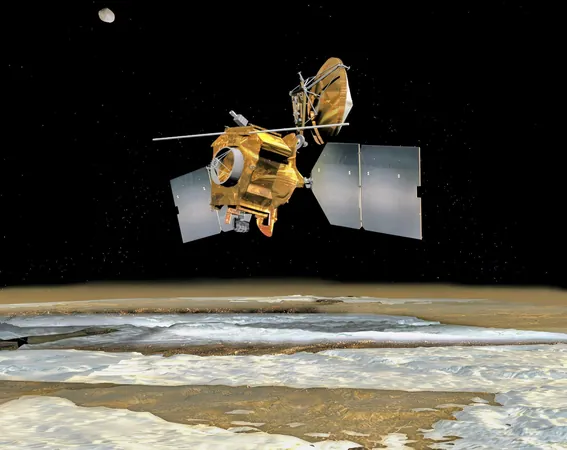
Mars Reconnaissance Orbiter Takes an Exciting New Spin!
2025-06-30
Author: Amelia
After nearly two decades soaring through the cosmos, NASA’s Mars Reconnaissance Orbiter (MRO) is embarking on a groundbreaking mission—literally rolling over to unveil Mars's hidden secrets!
Engineers have taught this veteran spacecraft to perform full-body rolls, sometimes tipping nearly upside down. The goal? To peer deeper beneath Mars's surface in the relentless quest for water and ice.
Revolutionizing the View of Mars’s Subsurface
This innovative technique developed by scientists at the Planetary Science Institute and NASA’s Jet Propulsion Laboratory allows MRO to enhance its exploration capabilities. Between 2023 and 2024, the orbiter executed three significant rotations, dubbed "very large rolls," revolutionizing the performance of its instruments.
Gareth Morgan from the Planetary Science Institute emphasizes, "Not only can you teach an old spacecraft new tricks, but you can also unlock entirely new subsurface regions to explore."
A Delicate Dance in Space
Originally designed for slight rolls of up to 30 degrees to adjust its camera angles, the Mars Reconnaissance Orbiter is uniquely equipped for flexible maneuvering. Project Manager Reid Thomas from JPL notes, "We’re special because our entire system is designed for constant rolling!" However, the ambitious 120-degree rolls demand meticulous planning and precise balance.
Precision in Every Roll: A Balancing Act
Each of MRO's five instruments has distinct operational needs. When one instrument is pointed at Mars, the others may lose their ideal view, necessitating a detailed scheduling process weeks in advance. Algorithms take the helm, guiding the orbiter to ensure that its solar panels remain optimally oriented towards the Sun and its antennas are aimed squarely at Earth.
Boosting Radar Returns with a Simple Flip!
One of the most thrilling aspects of these massive rolls is their impact on SHARAD, the orbiter’s Shallow Radar instrument. Designed to penetrate half a mile to 1.2 miles (0.8 – 1.9 kilometers) beneath Mars’s surface, SHARAD can identify different materials—rock, sand, and ice—crucial for future astronauts on their quests for water.
While SHARAD usually struggles with signal muddling due to interference from the orbiter itself, flipping it 120 degrees clears the path for a crystal-clear signal, boosting signal strength by tenfold or more! However, these maneuvers do come at a cost; during them, MRO sacrifices communication with Earth and battery recharging, limiting such extensive rolls to just one or two times a year for the time being.
A Legacy of Discovery Continues
Not just SHARAD, but also the Mars Climate Sounder, another essential instrument, has adapted to this new rolling strategy. It tracks climate changes, like temperatures and dust storm patterns, and has replaced its failing gimbal system with reliance on MRO’s roll capabilities.
After 18 remarkable years in orbit, the Mars Reconnaissance Orbiter continues to defy age, proving it can still deliver valuable insights about Mars. By embracing new maneuvers, MRO is not just peeking below the Martian surface; it is forging pathways to uncover potential water reserves waiting to be discovered.









 Brasil (PT)
Brasil (PT)
 Canada (EN)
Canada (EN)
 Chile (ES)
Chile (ES)
 Česko (CS)
Česko (CS)
 대한민국 (KO)
대한민국 (KO)
 España (ES)
España (ES)
 France (FR)
France (FR)
 Hong Kong (EN)
Hong Kong (EN)
 Italia (IT)
Italia (IT)
 日本 (JA)
日本 (JA)
 Magyarország (HU)
Magyarország (HU)
 Norge (NO)
Norge (NO)
 Polska (PL)
Polska (PL)
 Schweiz (DE)
Schweiz (DE)
 Singapore (EN)
Singapore (EN)
 Sverige (SV)
Sverige (SV)
 Suomi (FI)
Suomi (FI)
 Türkiye (TR)
Türkiye (TR)
 الإمارات العربية المتحدة (AR)
الإمارات العربية المتحدة (AR)